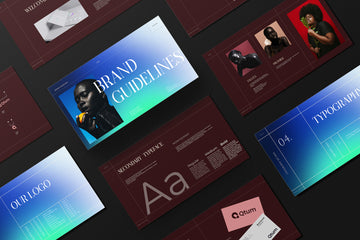Introduction
A company style guide is a vital document that ensures brand consistency and helps maintain a cohesive brand identity across all communication channels. It serves as a reference for employees, partners, and external agencies to align with the company's vision and voice. This article delves into the comprehensive process of creating an effective style guide, providing detailed insights into each component and its significance.
Understanding the Company Brand
Brand Identity
Understanding the core of your brand identity is crucial. This includes the logo, colors, and fonts that make up the visual aspect of your brand. Your brand identity should reflect the company's core values and mission.
Core Values
Identify the fundamental beliefs that guide the behaviors and decisions within the company. These values are the essence of your company's culture and help shape your brand's identity.
Brand Mission
Clearly articulate your company's purpose. This mission statement should convey what the company stands for and what it aims to achieve.
Brand Vision
Define the long-term goals and aspirations of your company. The brand vision gives direction and helps in strategic planning.
Elements of a Style Guide
Logos
The logo is a critical component of a brand's identity. Guidelines should include the primary logo, acceptable variations, clear space requirements, and examples of incorrect usage to maintain consistency.
Color Palette
Define the primary and secondary colors used in the brand's materials. Provide color codes (RGB, CMYK, Hex) and usage guidelines to ensure consistent application across all media.
Typography
Detail the font families, sizes, and styles to be used. Explain the hierarchy and how different fonts should be applied in various contexts, from headings to body text.
Imagery
Specify the style of images that align with the brand. Include guidelines for photography, illustrations, and iconography to ensure a unified visual presentation.
Voice and Tone
Outline the brand's voice and how it should be adapted for different contexts and audiences. This section helps maintain a consistent tone in all communications.
Messaging
Provide key messages, taglines, and the brand story. This ensures that everyone communicating on behalf of the company conveys the same core messages.
Copywriting Guidelines
Establish rules for grammar, punctuation, capitalization, and writing style. This ensures that all written content is consistent and professional.
Digital Media Guidelines
Website Guidelines
Provide instructions on how the brand should be represented online. This includes website design, user experience, and content guidelines.
Social Media
Outline the brand's approach to social media, including tone, post frequency, and visual guidelines.
Email Templates
Create standardized email templates to ensure brand consistency in email communications.
Online Advertising
Define the style and tone for online ads, ensuring they align with the overall brand strategy.
Print Media Guidelines
Brochures
Provide templates and guidelines for creating brochures, ensuring they align with the brand's visual identity.
Flyers
Detail the design elements and messaging for flyers.
Business Cards
Specify the layout, fonts, and color schemes for business cards.
Print Advertisements
Provide guidelines for creating print ads that maintain brand consistency.
Internal Communication
Memos
Standardize the format and style of internal memos.
Internal Emails
Ensure internal emails follow the same style and tone as external communications.
Presentations
Create templates for presentations that align with the brand's visual identity.
External Communication
Press Releases
Provide a template and guidelines for press releases to maintain a consistent brand message.
Client Communication
Standardize the tone and style of client communications.
Public Announcements
Ensure public announcements reflect the brand's voice and values.
Legal and Compliance
Trademark Usage
Detail the correct use of trademarks to protect brand integrity.
Legal Disclaimers
Include necessary legal disclaimers to ensure compliance with regulations.
Accessibility
Ensure all communications are accessible to individuals with disabilities.
Implementing the Style Guide
Training Employees
Provide training to ensure all employees understand and follow the style guide.
Regular Updates
Regularly update the style guide to reflect any changes in the brand strategy.
Feedback Mechanisms
Create a system for receiving and implementing feedback on the style guide.
Maintaining Brand Consistency
Monitoring and Evaluation
Regularly monitor and evaluate all brand communications to ensure consistency.
Periodic Reviews
Conduct periodic reviews of the style guide to ensure it remains relevant.
Compliance Checks
Implement compliance checks to ensure adherence to the style guide.
Case Studies and Examples
Successful Style Guides
Provide examples of successful style guides from other companies to illustrate best practices.
Lessons Learned
Share lessons learned from the development and implementation of the style guide.
Conclusion
Summarize the importance of a style guide in maintaining brand consistency and ensuring effective communication.
FAQs
What is the purpose of a style guide? A style guide ensures consistent branding across all communication channels, helping maintain a cohesive brand identity.
How often should a style guide be updated? A style guide should be reviewed and updated regularly to reflect any changes in the brand strategy.
Who should use the style guide? The style guide should be used by all employees, partners, and external agencies involved in brand communications.
What elements should be included in a style guide? A style guide should include guidelines on logos, color palettes, typography, imagery, voice and tone, messaging, and more.
How can a company ensure employees follow the style guide? Provide training, regular updates, and feedback mechanisms to ensure employees understand and adhere to the style guide.
Why is brand consistency important? Brand consistency helps build trust and recognition among customers, enhancing the overall brand experience.
Conclusion
Creating a comprehensive style guide is essential for maintaining brand consistency and ensuring that all communications reflect the company's identity and values. By following the guidelines outlined in this article, companies can develop an effective style guide that serves as a valuable resource for all stakeholders.






